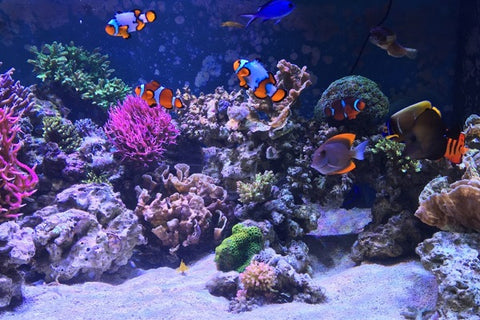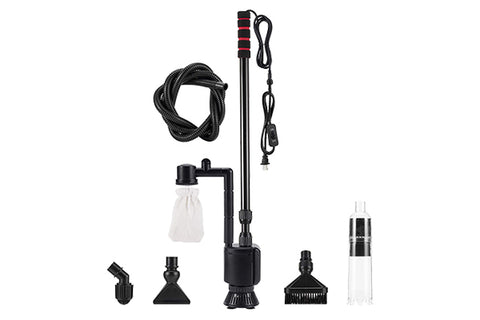Setting up a saltwater aquarium is much similar to starting a freshwater one. Most people think it’s challenging to keep a saltwater aquarium, but things can be simpler once you grasped the skills.
In the article, we’ll give you a detailed guide on how to set up a saltwater aquarium. Stick with us and start a saltwater aquarium journey now!
Make a general plan
Whether you’re setting up a saltwater aquarium or a freshwater aquarium, you should make a plan first. It includes what kind of fish to keep, how many fish to add, what kind of tank, equipment and decorations to buy, how to arrange the equipment and decorations, and so on.
Once you can make a detailed plan, you’ll find the following steps are much easier.

Prepare your tank
After buying a tank from the store, you need to clean it first even if it is a new one. Some dirt can not be seen by naked eyes. To provide your fish with a clean environment, this step can not be skipped.
Remember not to use things that contain chemical components to clean your tank, such as soap. The chemical components of this stuff will remain in your tank and poison your fish in the future.
By the way, do not forget to add some water to the tank and check for leakage after some hours.
Put your tank in a suitable place
There are many considerations that you need to pay attention to when you place the tank:
- Is the ground flat to avoid falling?
- Whether the ground can support the weight of a well-established tank?
- Will the water temperature fluctuate according to room temperature?
- Is it convenient for you to observe and take care of fish?
- Is it convenient for you to do tank maintenance?
- Will the sounds from the tank influence your daily life?
- Is there enough space around the fish tank to avoid wetting other stuff?
Clean and set up the substrate
Having placed your aquarium, you can start to add things to it. The first thing you need to add is the substrate. But before adding, you should clean it with clean water first although it’s newly bought from the store.
The reason to clean it is the same as the reason to clean your tank. But there is another reason for doing this, which is to avoid getting a white/milky white tank.
The material of the substrate depends on the fish you plan to keep. If they like soft substrate, you can make a sandy substrate. But if they don’t have special requirements, you can use pebbles or gravel. One thing you should keep in mind is that you can not use any materials with sharp edges, otherwise, your fish may get hurt.
Dechlorinate the water and add it to the tank
After setting up the substrate, you can add the water to your tank now. The water used for fish-keeping is special. You can not just pour tap water into your tank since it is high in metal, chlorine and other chemical elements. Thus, you should dechlorinate it first. You can achieve this by adding some water conditioner to the water. But how much water conditioner to add should be determined by the real conditions.
Note: Do not forget to add some salt to the water. The amount is up to the salinity your fish require.
Install and test the equipment
The next step after adding water is to install and test the equipment. Normally, it’s necessary to buy a filter and a heater. Except for these, you’d better prepare a light, a UV fertilizer, a protein skimmer, some pumps (water pump, air pump and wave maker pump), and so on.
Regarding that there is salt in a saltwater aquarium, which might corrode some equipment, the equipment you choose should be anti-corrosion. If you can’t buy this, you can also opt to buy equipment that can be installed outside the tank.
Clean and add the decorations
We have mentioned one decoration above, which is the substrate. Other decorations for a saltwater aquarium include corals, live rocks, driftwood, etc.
To avoid overstock, you should be careful with the number of decorations. And to avoid water pollution, you should rinse, soak or boil some decorations before putting them in the tank. For instance, you should soak or boil the driftwood to remove the tannins in it.
The decorations can help mimic the fish’s natural habitat. Thereby, you should take the arrangement of the decorations seriously, creating a more natural environment.
Cycle your tank
Till now, you’re almost done with the setting up of a saltwater aquarium. Before adding the fish to it, there is one thing you need to do. It is vital in creating a healthy and stable environment for your fish.
Cycling the fish tank is a process to allow beneficial bacteria to build up in your aquarium. And the beneficial bacteria do well in decomposing the toxins, such as ammonia and nitrates, in your aquarium. With the beneficial bacteria, your tank will be more stable and the workload of the filter can be reduced.
Note: While cycling the tank, you should check the water regularly. Never put your fish in the tank unless the water parameters are acceptable for them.
Add fish to your aquarium
Now comes the most exciting part-adding fish! Here is a list of saltwater fish for beginners:
- Clownfish
- Cardinal fish
- Damselfish
- Yellow watchman goby
Most beginners will make a mistake when adding fish. They will add all the fish at one time, no matter how many they have. It’s disastrous for your newly established tank.
The biological system in a new aquarium is very fragile. If you add too many fish at one time, the waste will increase suddenly, leaving little time for the beneficial bacteria and filter to remove it. Thus, add fish separately. If you have territorial fish, add them finally, in case they attack other fish that enter their territory.
Conclusion
Now you have grasped the skills about establishing a saltwater aquarium, but it’s never the end of fish-keeping. To better take care of your fish, you should never stop checking the water parameters and be careful during daily care.
If you are considering establishing a saltwater aquarium in your home and don’t know how to do it. Hope this guide can help you solve all your problems and successfully set up a stunning saltwater aquarium. By the way, if you think this article is helpful, do not forget to share it with your aquarist friends.




Comments (0)
Back to Beginner Guide & Advice